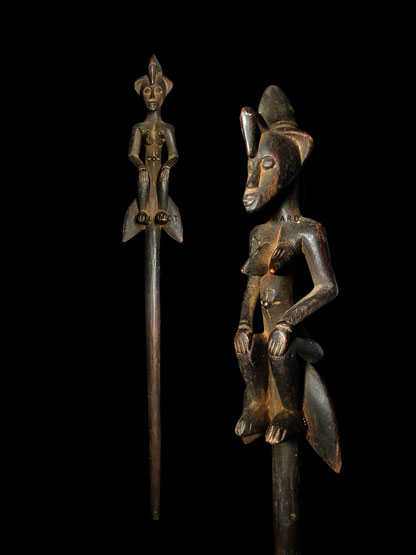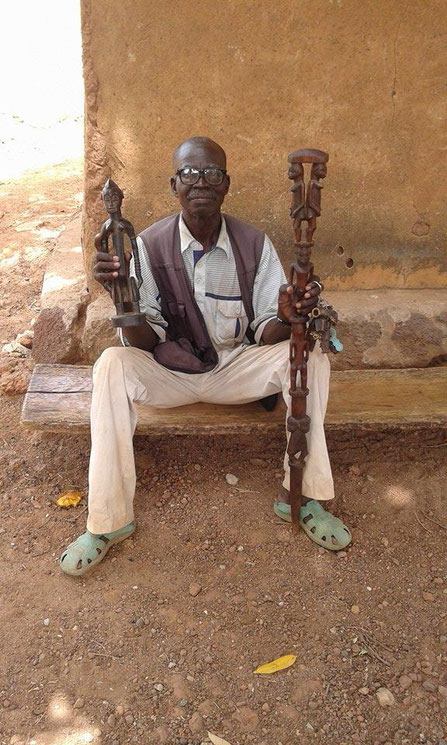
Similar to a scepter the dancer of the Kpelié mask does hold a stick in one of his hands and leads the ceremony with it. Karl-Heinz Krieg named this stick "Kumbol", and the Kufulo (or Koufouloh), a sub-group of the Senufo living south of Korhogo, name it "Jumbol".
There is always a sitting female Tugubele statue on a semi circle shaped base that is placed on top of the stick. The lenght of this ceremonial accessory varies from short version of about 20 cm up to 60 cm long sticks. They can be carved in wood, but also casted in shiny brass.
There are sticks known, where the Tugubele is detachable and functions as a single figure. But in general the spirit is carved on a half circle form in one piece with the stick. For the diviner, who is the keeper of the Jumbol, this Tugubele is his master. That is one other explanation, that the statue can be removed and can function as diviners tool itself.
Karl-Heinz Krieg describes in his book "Kunst und Religion bei den Gbato-Senufo, Elfenbeinküste" on page 35 that these sticks are also used as a trophy stick in the secret society of the Poro, or on page 41 that these sticks can be borrowed to neighboured Poro societies. On page 138 he defines the name Kumbol as a dancing stick for Sohole, the initiation phase of young men between 20 and 27 years old, at the Wolo dance.
The Jumbol is not to be confused with the nearly same looking Tefalapica, a trophy stick for a farmer who did win a chopping competition in working the fields. The Tefalapica has a minimum lengh of 100 cm up to 150 cm, some decorations such as carved rings or rills are on the stick in additon, and always a female Tugubele on top. (Afrika Begegnung, Artur Elmer, page 50 - 52). Robert Goldwater describes in his book "Senufo - Sculpture from west africa" on images 128-136 as a stick with the name "daleu".

The shown Jumbol was carved by Zana (Zanafagua) Coulibaly, a Koulé who lived in Kanoroba. Born in 1940, Zana died 2019 in Natal. He learned carving from his father and he left a huge repertoire of objects, such as masks, statues, tools and furniture.
In his case it is difficult to determine the date of origine. Zana had no characteristic handwriting like Ziehouo Coulibaly from Korhogo, who is in the same generation of Senufo carvers. But Zana's style is very elegant.
His Jumbol, made before 2000, is a very beautifully carved ceremonial object. It fullfills all the features of style and elegance in sense of Senufo esthetics.
The photo of Zana Coulibaly was made by Souleymane Arachi in April 2015 in Kanoroba, Ivory Coast. On that image he holds, beside a Tugubele statue, a walking stick, he made for himself.
Content and image by Markus Ehrhard

